Intel Core i7 3960X (Sandy Bridge E) Review: Keeping the High End Alive
by Anand Lal Shimpi on November 14, 2011 3:01 AM EST- Posted in
- CPUs
- Intel
- Core i7
- Sandy Bridge
- Sandy Bridge E
Gaming Performance
Most games have a tough enough time stressing more than four cores, so the move to the 3960X won't do much for gaming in most cases (particularly when GPU bound). That being said, the added cache may help give SNB-E a slight bump over its quad-core brethren.
Civilization V
Civ V's lateGameView benchmark presents us with two separate scores: average frame rate for the entire test as well as a no-render score that only looks at CPU performance.

In GPU bound scenarios the 3960X is no different than the 2600K. Civ V is a unique game in that its CPU workload does scale reasonable well across multiple cores:
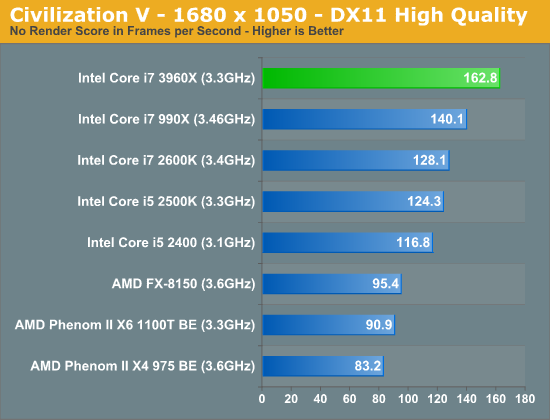
Here the 3960X is nearly 30% faster than the 2600K.
Crysis: Warhead
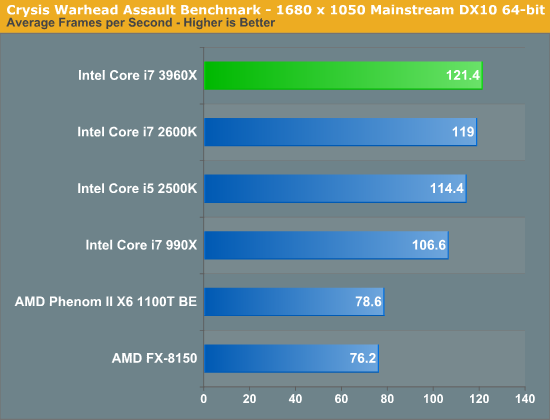
Dawn of War II
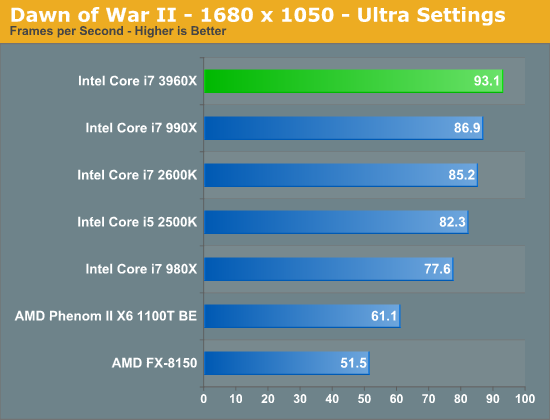
The larger cache helps give the 3960X a 9% advantage over the 2600K in Dawn of War II. At 1680 x 1050 the game isn't entirely GPU bound on our 5870.
DiRT 3
We ran two DiRT 3 benchmarks to get an idea for CPU bound and GPU bound performance. First the CPU bound settings:

DiRT 3 is an example of a CPU bound title (at lower resolutions) that doesn't scale well with core count or cache size. The 3960X is barely 2% faster than the 2600K.
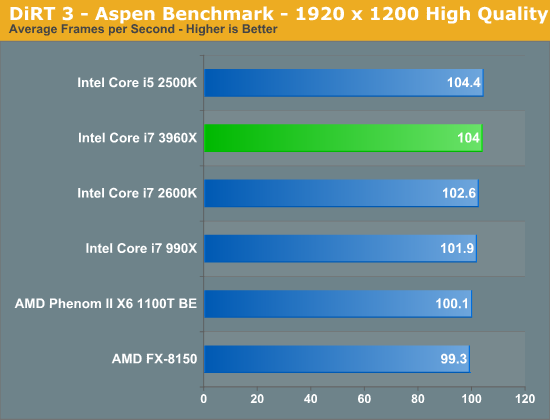
Metro 2033
It is interesting to note that while SNB-E and SNB perform similarly here, both parts do offer a performance improvement over the Gulftown based 990X.
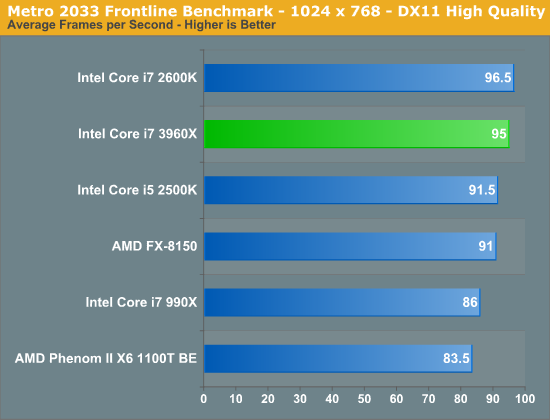
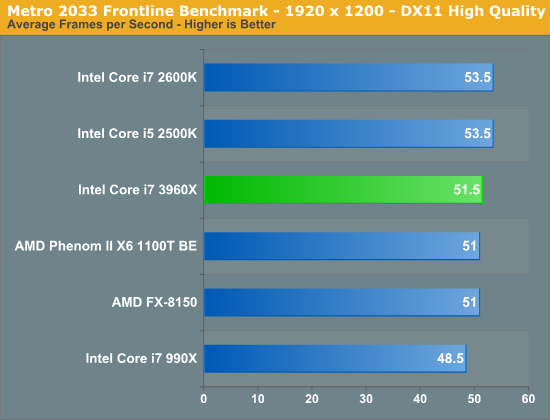
Rage vt_benchmark
While id's long awaited Rage title doesn't exactly have the best benchmarking abilities, there is one unique aspect of the game that we can test: Megatexture. Megatexture works by dynamically taking texture data from disk and constructing texture tiles for the engine to use (note that Rage doesn't store textures in a GPU-usable format). As a result whenever you load a texture, Rage is transcoding the texture on the fly. This is normally done by the CPU.
The Benchmark: vt_ are all the virtual texture commands. Vt_benchmark flushes the texture cache and then times how long it takes to transcode all the textures needed for the current scene, from 1 thread to X threads. Thus when you run vt_benchmark 8, for example, it will benchmark from 1 to 8 threads (the default appears to depend on the CPU you have). Since transcoding is done by the CPU this is a pure CPU benchmark. I present the best case transcode time at the maximum number of concurrent threads each CPU can handle:
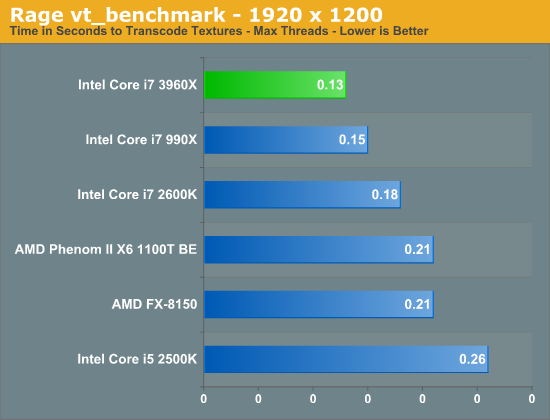
Starcraft 2
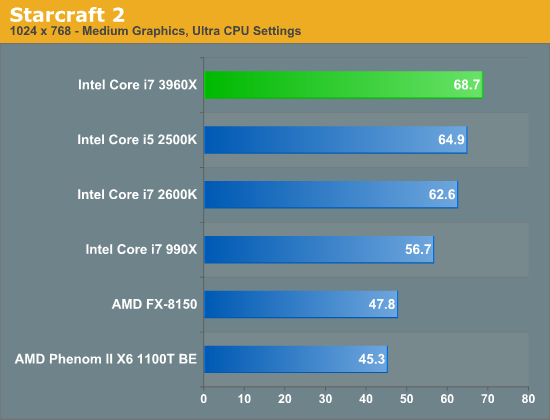
World of Warcraft
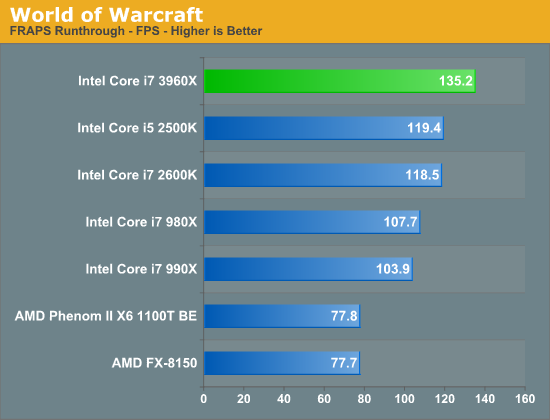
WoW does enjoy the 3960X's larger cache, here we see a 13% increase in performance compared to the regular Sandy Bridge parts.










163 Comments
View All Comments
xpclient - Monday, November 14, 2011 - link
I read Intel is not going to release AHCI/SATA/Matrix RAID drivers for 32-bit Windows XP for X79. Why??? Without AHCI, performance is going not going to be optimal. For those that dual boot with Windows 7, this means changing the settings from AHCI to IDE every time you boot into XP.Rick83 - Monday, November 14, 2011 - link
And I heard that USB 3 had no drivers for my Win95 D either!B3an - Monday, November 14, 2011 - link
Because no one in there right mind would buy this high-end platform then use a decade old POS operating system. Waste of Intels time to support it and XP needs to die already.XP will take little advantage of SSD's or even new HDD's properly, some drives wont even work at all on it, and it lacks the same level of support and performance for CPU features and multiple cores that Win7 has. If you really need to run some old software just use XP mode in Win 7 or use VM software.
xpclient - Monday, November 14, 2011 - link
Are you not aware of multi-core benchmarks? http://www.infoworld.com/t/platforms/generation-ga... Windows 7 does not perform faster than XP until you reach eight cores or higher.Peskarik - Monday, November 14, 2011 - link
"Just as with previous architectures, installing fewer DIMMs is possible, it simply reduces the peak available memory bandwidth."So, I have:
Asus P8Z68-V Pro/Gen3 motherboard
Intel Core i7 2600K
Corsair Vengeance Red, 2x4GB, DDR3-1600, CL9@1.5V
When I am in BIOS the memory is set to 1333Mhz, and I had to manually set it to 1600, though I am not sure whether it actually runs at this speed (how can I check?).
Does the above sentence from the article mean that with 8GB RAM I do not have full memory bandwidth and that if I install 16GB RAM (I have 4 slots) then I have full 1600Mhz automatically?
kr1s69 - Monday, November 14, 2011 - link
Sandy Bridge E is quad channel and so needs 4 DIMM's to obtain the peak bandwidth. Your Sandy Bridge system is dual channel and so you need 2 DIMM's to obtain the peak bandwidth. This is what you currently have installed, so no need to worry.The statement you quoted is basically saying this motherboard would boot with less than 4 DIMM's installed, that is all.
Sandy Bridge defaults to 1333Mhz but you can change this in the BIOS to 1600Mhz as you have done. You can download CPU-Z to confirm what speed your RAM is set to.
piroroadkill - Monday, November 14, 2011 - link
Set the O/C Profile to X.M.P.This uses the eXtreme Memory Profile provided by your RAM. Basically, standard SPD ratings don't go as high as 1600. XMP is required for this, it's a custom Intel extension to SPD.
piroroadkill - Monday, November 14, 2011 - link
Although it's supposed to work, in my experience I had to set my RAM to DDR3-1600 anyway. Ho hum.lukarak - Monday, November 14, 2011 - link
This is not a great update. I wonder if 2011 will be the socket for ivy bridge E. If that's the case, it could be a good buy for somebody transitioning from an older system.dlitem - Monday, November 14, 2011 - link
There were some rumors / news circulating earlier that VT-d is bugged. Is that actually the case? SB-E is The workstation platform and losing VT-d is kind of a shame, as there actually are people who might have benefited from it.Also, a lot of us are still running our trusty 3 year old Quad-Bloomfields that have served us so well, so including one LGA1366 Quad-core would have be a really nice thing.